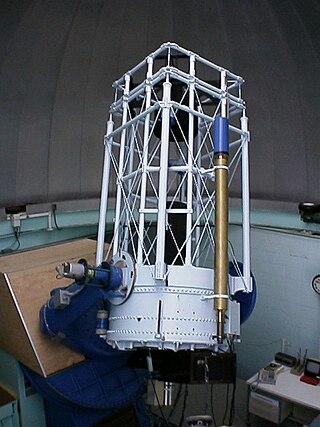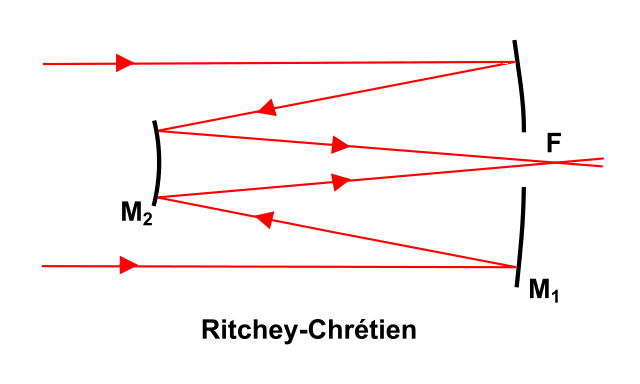Loading AI tools
Specialized Cassegrain telescope From Wikipedia, the free encyclopedia
A Ritchey–Chrétien telescope (RCT or simply RC) is a specialized variant of the Cassegrain telescope that has a hyperbolic primary mirror and a hyperbolic secondary mirror designed to eliminate off-axis optical errors (coma). The RCT has a wider field of view free of optical errors compared to a more traditional reflecting telescope configuration. Since the mid 20th century, a majority of large professional research telescopes have been Ritchey–Chrétien configurations; some well-known examples are the Hubble Space Telescope, the Keck telescopes and the ESO Very Large Telescope.


The Ritchey–Chrétien telescope was invented in the early 1910s by American astronomer George Willis Ritchey and French astronomer Henri Chrétien. Ritchey constructed the first successful RCT, which had an aperture diameter of 60 cm (24 in) in 1927 (Ritchey 24-inch reflector). The second RCT was a 102 cm (40 in) instrument constructed by Ritchey for the United States Naval Observatory; that telescope is still in operation at the Naval Observatory Flagstaff Station.
As with the other Cassegrain-configuration reflectors, the Ritchey–Chrétien telescope (RCT) has a very short optical tube assembly and compact design for a given focal length. The RCT offers good off-axis optical performance, but its mirrors require sophisticated techniques to manufacture and test. Hence the Ritchey–Chrétien configuration is most commonly found on high-performance professional telescopes.
A telescope with only one curved mirror, such as a Newtonian telescope, will always have aberrations. If the mirror is spherical, it will suffer primarily from spherical aberration. If the mirror is made parabolic, to correct the spherical aberration, then it still suffers from coma and astigmatism, since there are no additional design parameters one can vary to eliminate them. With two non-spherical mirrors, such as the Ritchey–Chrétien telescope, coma can be eliminated as well, by making the two mirrors' contribution to total coma cancel. This allows a larger useful field of view. However, such designs still suffer from astigmatism.
The basic Ritchey–Chrétien two-surface design is free of third-order coma and spherical aberration.[1] However, the two-surface design does suffer from fifth-order coma, severe large-angle astigmatism, and comparatively severe field curvature.[2]
When focused midway between the sagittal and tangential focusing planes, stars appear as circles, making the Ritchey–Chrétien well suited for wide field and photographic observations. The remaining aberrations of the two-element basic design may be improved with the addition of smaller optical elements near the focal plane.[3][4]
Astigmatism can be cancelled by including a third curved optical element. When this element is a mirror, the result is a three-mirror anastigmat. Alternatively, a RCT may use one or several low-power lenses in front of the focal plane as a field-corrector to correct astigmatism and flatten the focal surface, as for example the SDSS telescope and the VISTA telescope; this can allow a field-of-view up to around 3° diameter.
The Schmidt camera can deliver even wider fields up to about 7°. However, the Schmidt requires a full-aperture corrector plate, which restricts it to apertures below 1.2 meters, while a Ritchey–Chrétien can be much larger. Other telescope designs with front-correcting elements are not limited by the practical problems of making a multiply-curved Schmidt corrector plate, such as the Lurie–Houghton design.
In a Ritchey–Chrétien design, as in most Cassegrain systems, the secondary mirror blocks a central portion of the aperture. This ring-shaped entrance aperture significantly reduces a portion of the modulation transfer function (MTF) over a range of low spatial frequencies, compared to a full-aperture design such as a refractor.[5] This MTF notch has the effect of lowering image contrast when imaging broad features. In addition, the support for the secondary (the spider) may introduce diffraction spikes in images.

The radii of curvature of the primary and secondary mirrors, respectively, in a two-mirror Cassegrain configuration are:
and
where
If, instead of and , the known quantities are the focal length of the primary mirror, , and the distance to the focus behind the primary mirror, , then and .
For a Ritchey–Chrétien system, the conic constants and of the two mirrors are chosen so as to eliminate third-order spherical aberration and coma; the solution is:
and
Note that and are less than (since ), so both mirrors are hyperbolic. (The primary mirror is typically quite close to being parabolic, however.)
The hyperbolic curvatures are difficult to test, especially with equipment typically available to amateur telescope makers or laboratory-scale fabricators; thus, older telescope layouts predominate in these applications. However, professional optics fabricators and large research groups test their mirrors with interferometers. A Ritchey–Chrétien then requires minimal additional equipment, typically a small optical device called a null corrector that makes the hyperbolic primary look spherical for the interferometric test. On the Hubble Space Telescope, this device was built incorrectly (a reflection from an un-intended surface leading to an incorrect measurement of lens position) leading to the error in the Hubble primary mirror.[7]
Incorrect null correctors have led to other mirror fabrication errors as well, such as in the New Technology Telescope.
In practice, each of these designs may also include any number of flat fold mirrors, used to bend the optical path into more convenient configurations. This article only discusses the mirrors required for forming an image, not those for placing it in a convenient location.
Ritchey intended the 100-inch Mount Wilson Hooker telescope (1917) and the 200-inch (5 m) Hale Telescope to be RCTs. His designs would have provided sharper images over a larger usable field of view compared to the parabolic designs actually used. However, Ritchey and Hale had a falling-out. With the 100-inch project already late and over budget, Hale refused to adopt the new design, with its hard-to-test curvatures, and Ritchey left the project. Both projects were then built with traditional optics. Since then, advances in optical measurement[8] and fabrication[9] have allowed the RCT design to take over – the Hale telescope, dedicated in 1948, turned out to be the last world-leading telescope to have a parabolic primary mirror.[10]

Seamless Wikipedia browsing. On steroids.
Every time you click a link to Wikipedia, Wiktionary or Wikiquote in your browser's search results, it will show the modern Wikiwand interface.
Wikiwand extension is a five stars, simple, with minimum permission required to keep your browsing private, safe and transparent.